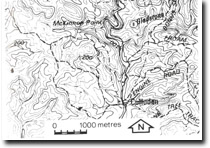8322-8 Freestone Creek
|
This information has been developed from the publications:
|
Location: | 098190. Eight kilometres north-east of Briagolong. | |
Abstract: | Type section, Avon River Group. | |
Access: | Briagolong - Dargo Road. | |
Ownership: | Crown land. | |
Geology: | Exposed along the Freestone creek gorge by the erosion of the gently southward plunging Freestone Creek Anticline, is the type section of the relatively flat-lying Upper Devonian to Lower Carboniferous sequence of freshwater sediments and intercalated volcanics of the Avon River Group. The Avon River Group is divided into four formations, each of which is widespread through all four are not always present together. These are the; Moroka Glen Formation, Willington Rhyolite, Mount Ken Conglomerate and Snowy Plains Formation. An angular conformity, represented by an erosion surface of moderate relief and produced by rapid denudation after the late-Middle Devonian igneous activity and uplift of the Tabberabberan Orogeny, can be observed in cliff sections at McKinnon Point as a contact between Ordovician metasediments and the basal conglomerate unit of the Moroka Glen Formation. The sediments of the Avon River Group are a sequence of mudstones, sandstones and conglomerates that become finer upwards through the sequence. So, although conglomerates dominate the basal part of the Avon River Group, the upper part is dominated by mudstones and sandstones. Intercalated within the lower part of the Avon River Group, are a series of basalts that have undergone burial metamorphism. These large lava flows which are reported higher in the sequence elsewhere, appear only as thin beds in the Moroka Glen Formation within the Freestone Creek section. Sedimentary processes were halted by the deposition of the Wellington Rhyolite, a series of ash flows, ash falls and lava flows with sediments, both volcanogenic and clastic, separating the pyroclastic from the lava flow material. At Freestone Creek, there are tow main rhyolite units. The lower, about 105 m thick, is overlain by 90 m of sandstone and mudstone, followed by the upper volcanic unit of 60 m thickness. A Late Devonian fish fauna has been obtained from grey mudstone directly overlying the lower volcanic unit. A second fish-bearing bed is known in the basal part of the Mount Kent Conglomerate. Here, the grey fish-bearing mudstone is succeeded by 165 m of sandstone and pebbly mudstone. The Freestone Creek fish fauna includes the antiarch Bothriolepis, which supplies the only definite Late Devonian age for the Avon River Group. The plant Taeniocrada langi, has been identified from the fish bed in the Wellington Rhyolite, other plant fossils found are Lepidodendron sp & Cordaites australes. Continuous with the Mount Ken Conglomerate, the Snowy Plains Formation is distinguished from the Mount Ken Conglomerate by the virtual absence of pebbly sandstone and conglomerate beds, and by a general trend from coarse to fine sandstones. The exact age of the Snowy Plains Formation is unresolved, at the Freestone Creek quarries, about 1200 m above the base of the Avon River Group, Cordaites australes assigned to the Late Devonian has been collected. In the absence of diagnostic Early Carboniferous fossils and of any major break sedimentation, the base of the Snowy Plains Formation is taken as Upper Devonian. Volcanicity continued during deposition of the Snowy Plains Formation. South of Culloden, the Snowy Plains Formation is overlain in the Freestone Creek gorge by Tertiary sediments. | |
Significance: | State. The Freestone Creek gorge exposure of the Avon River Group represents one of the most complete stratigraphic sections of the Group, since often large sections are faulted out, or are so deformed that recognition of the complete sequence is impossible. The gorge trends sub-parallel to the low-plunging Freestone Creek Anticline, so that a section at 90 degrees to strike is almost continually maintained. | |
Management: | The exposures of the Avon River Group occur in the Freestone Creek gorge and the Freestone Creek quarries. Reservoir construction which would obscure the outcrops would degrade the significance of the site. | |



